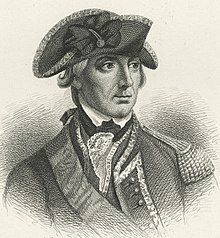
Back ويليام هاو، الفيكونت الخامس لعائلة هاو Arabic ويليام هاو ARZ William Howe Catalan William Howe, 5. vikomt Howe Czech William Howe Danish William Howe, 5. Viscount Howe German William Howe Esperanto William Howe Spanish ویلیام هاو Persian William Howe Finnish
General The Right Honourable The Viscount Howe | |
|---|---|
 Engraving by Henry Bryan Hall | |
| Commander-in-Chief of British land forces | |
| In office September 1775 – May 1778 | |
| Monarch | George III |
| Preceded by | Thomas Gage |
| Succeeded by | Henry Clinton |
| Member of Parliament for Nottingham | |
| In office 1758–1780 Serving with Willoughby Aston (1758–1761) Serving with John Plumptre (1761–1774) Serving with Charles Sedley (1774–1778) Serving with Abel Smith (1778–1779) Serving with Robert Smith (1779–1780) | |
| Preceded by | George Howe |
| Succeeded by | Daniel Coke |
| Personal details | |
| Born | 10 August 1729 England |
| Died | 12 July 1814 (aged 84) Twickenham, United Kingdom |
| Resting place | Twickenham |
| Political party | Whig |
| Spouse |
Frances Connolly (m. 1765) |
| Military service | |
| Allegiance | |
| Branch/service | |
| Years of service | 1746–1814 |
| Rank | General |
| Commands | Colonel, 60th (later 58th) Regiment of Foot Colonel, 46th Regiment of Foot Commander-in-Chief of British land forces Colonel, 19th Light Dragoons Northern District |
| Battles/wars | |
William Howe, 5th Viscount Howe, KB, PC (10 August 1729 – 12 July 1814), was a British Army officer who rose to become Commander-in-Chief of British land forces in the Colonies during the American War of Independence. Howe was one of three brothers who had distinguished military careers. In historiography of the American war he is usually referred to as Sir William Howe to distinguish him from his brother Richard, who was 4th Viscount Howe at that time.
Having joined the army in 1746, Howe saw extensive service in the War of the Austrian Succession and Seven Years' War. He became known for his role in the capture of Quebec in 1759 when he led a British force to capture the cliffs at Anse-au-Foulon, allowing James Wolfe to land his army and engage the French in the Battle of the Plains of Abraham. Howe also participated in the campaigns to take Louisbourg, Belle Île and Havana. He was appointed Lieutenant-Governor of the Isle of Wight, a post he held until 1795.
Howe was sent to North America in March 1775, arriving in May after the American War of Independence broke out. After leading British troops to a costly victory in the Battle of Bunker Hill, Howe took command of all British forces in America from Thomas Gage in September of that year. Howe's record in North America was marked by the successful capture of both New York City and Philadelphia. However, poor campaign planning for 1777 contributed to the failure of John Burgoyne's Saratoga campaign, which played a major role in the entry of France into the war. Howe's role in developing those plans and the degree to which he was responsible for British failures that year (despite his personal success at Philadelphia) have both been subjects of contemporary and historic debate.
He was knighted after his successes in 1776. He resigned his post as Commander-in-Chief, British land forces in America, in 1777, and the next year returned to England, where he was at times active in the defence of the British Isles. He sat in the House of Commons from 1758 to 1780 for Nottingham. He inherited the Viscountcy of Howe upon the death of his brother Richard in 1799. He married, but had no children, and the viscountcy became extinct with his death in 1814.